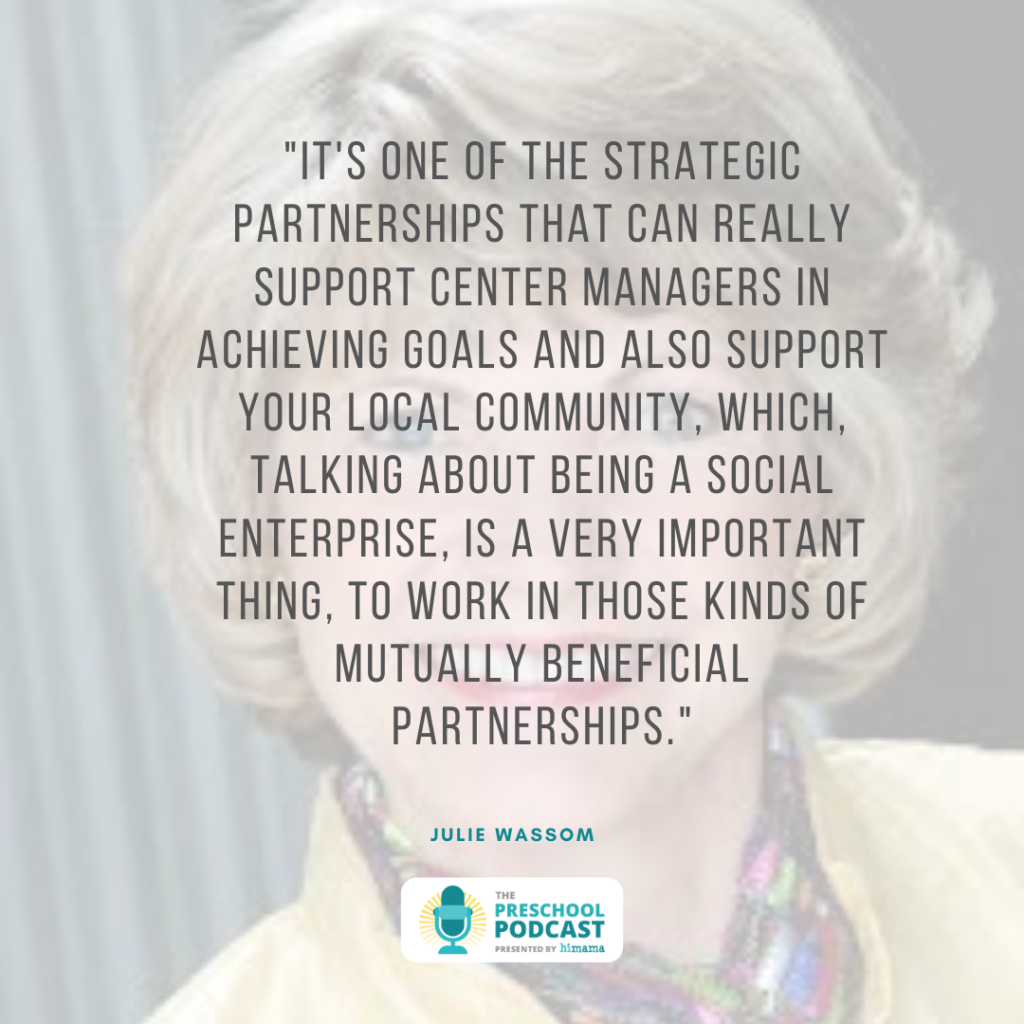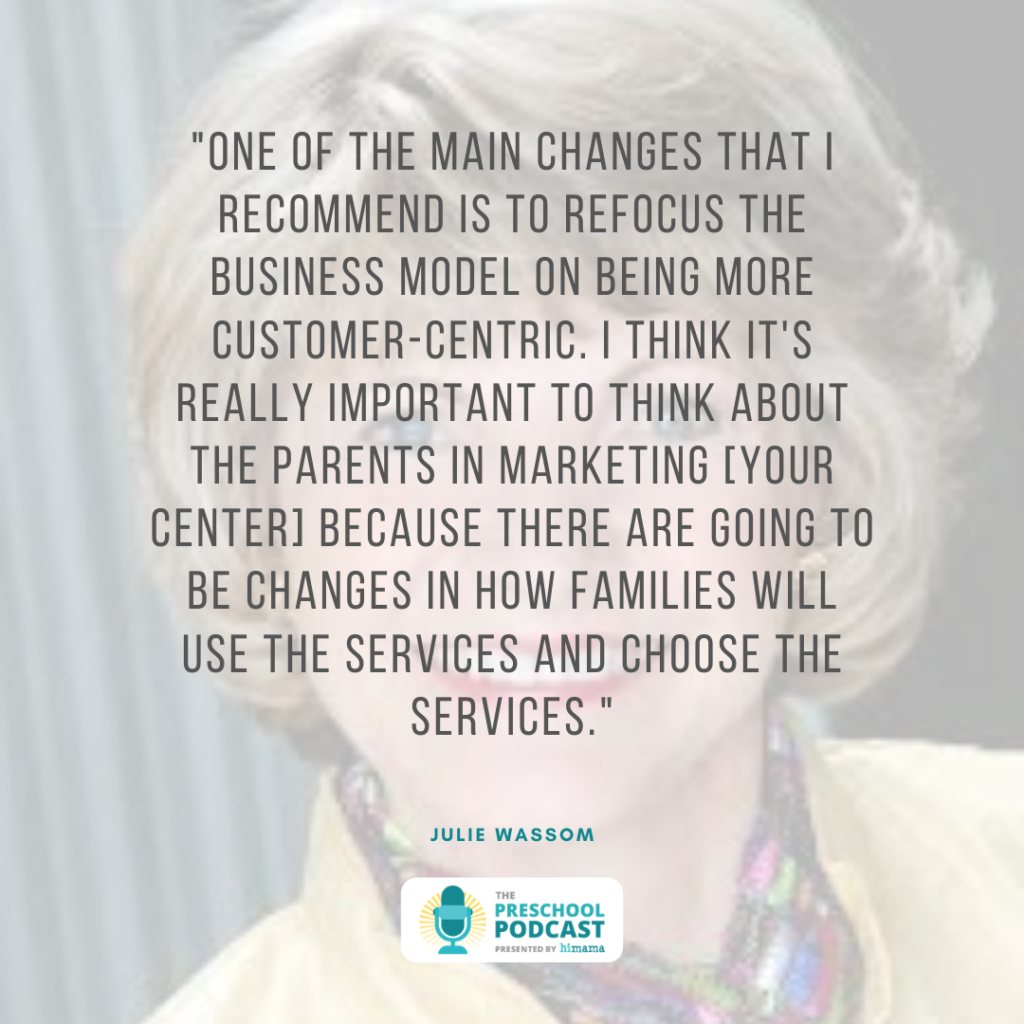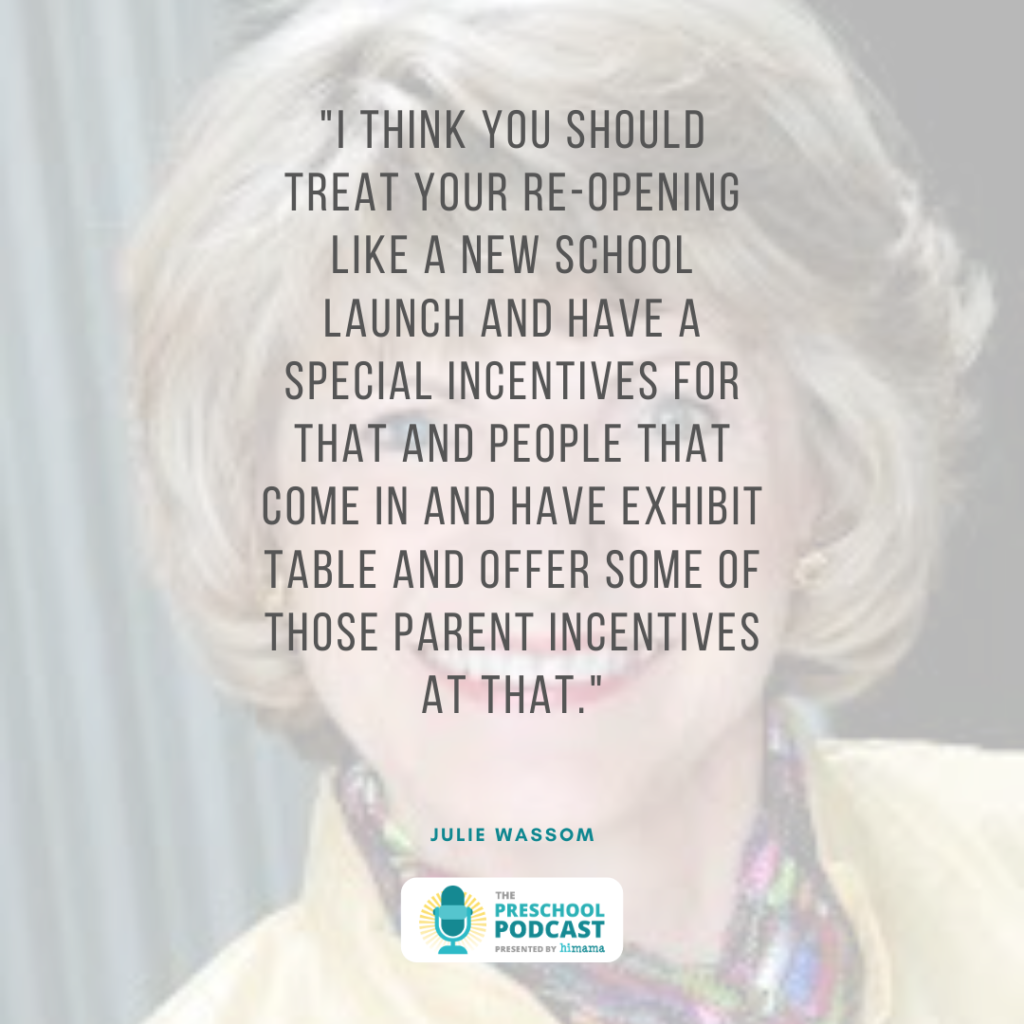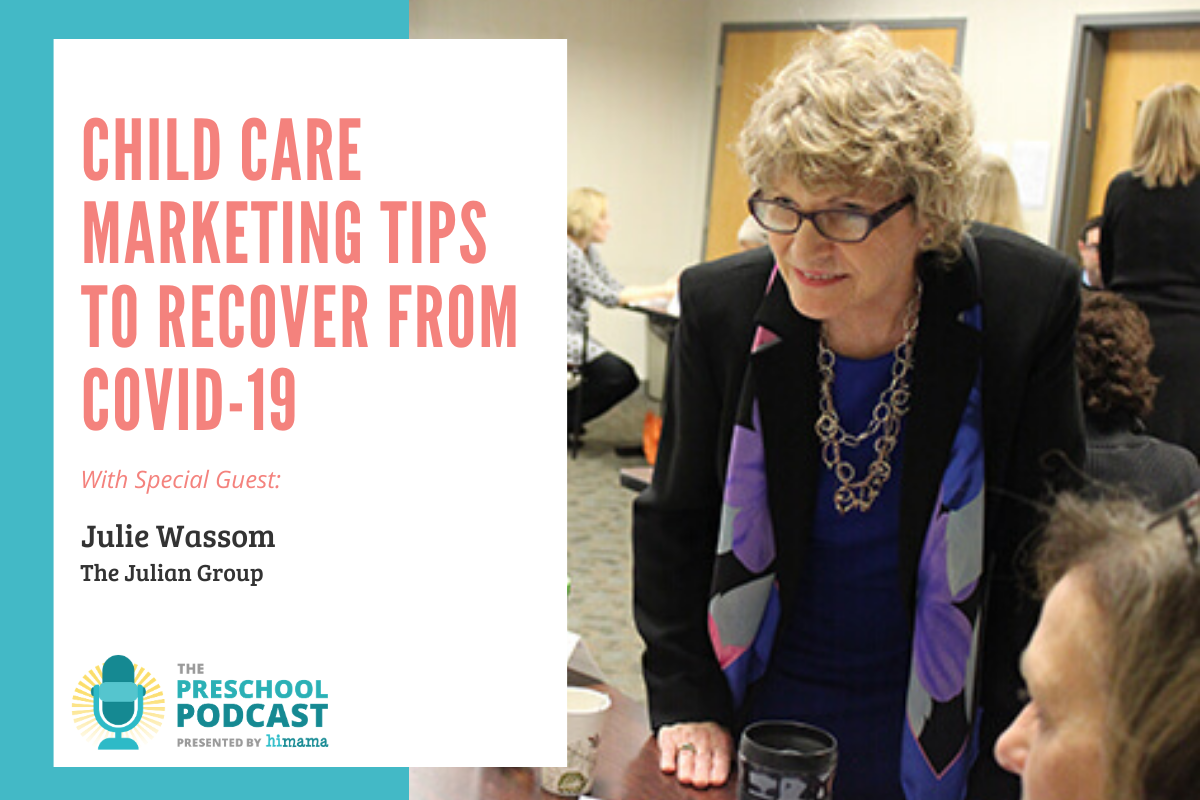Episode 200 – The COVID-19 pandemic has really challenged the child care community. In this episode, we talk with Julie Wassom, child care marketing expert, about the opportunities that lie beneath the challenge of the COVID-19 pandemic. We cover areas that business owners can control and focus on rebranding their services to families in order to hit the ground running when programs are ready to reopen again.
Resources:
Episode Transcript
Julie WASSOM:
It’s one of the strategic partnerships that can really support center managers in achieving goals and also support your local community, which, talking about being a social enterprise, is a very important thing, to work in those kinds of mutually beneficial partnerships.

Ron SPREEUWENBERG:
Julie, welcome to the Preschool Podcast!
WASSOM:
Thank you, it’s a pleasure to be with you!
SPREEUWENBERG:
We’re delighted to have you, Julie. For our listeners, we have Julie Wassom on the show. She’s president of the Julian Group. And she has spent a lot of time helping out childcare [and] early-childhood education programs in the U.S. and I believe internationally, too.
Julie, welcome to the show. Tell us a little bit about yourself and how you started getting involved in early-childhood education.
WASSOM:
Well, many years ago, Ron, I began working in the early care and education field as a director of sales for one of the multi-unit childcare companies in the United States. And after a few years and an acquisition, I made a friendly departure from that company and began my own business in helping programs all over the world, really, to generate inquiries and convert those inquiries into registrations and enrollments and retain the parents and build their top-line revenue so that they could provide the kind of quality program that they want to provide and hire and retain staff and be able to sustain the business.
So, I’ve been doing that for many years, both on-site and virtually and with a library of resources to support providers of all different types, all over everywhere, including Canada. So, Canada, US, Australia, New Zealand – mostly English speaking countries. And it’s really been delightful to see the impact of the kinds of practical ideas I can provide for them.
SPREEUWENBERG:
Awesome! And of course, we’re in this COVID-19 pandemic right now. So, any conversation we have has to be taken in that context for our podcast, but also for early-childhood education programs. So, let’s start there: When it comes to marketing, what should our childcare and early-childhood education programs be doing differently when it comes to their marketing, given the current environment we’re in?
WASSOM: That’s a really good question. And it’s a difficult time for many early care and education programs. And many, many of them are closed. So, now I think is a time to really start expanding their thinking about how they’re going to be marketing, [both] now and in the future.
John F. Kennedy described the Chinese symbol for “crisis” as having two brush strokes. One means danger and the other means opportunity. So, even though the current times are really uncertain – and they’re scary for some early care and education businesses – I also think they’re really ripe with opportunity for ways that you can build an effective enrollment recovery plan.
And one of the main changes that I recommend is to refocus the business model on being more customer-centric. The core business of early care and education will remain the same and that, of course, is serving the children with the development and education and learning opportunities and the growth that they’ve always done for the children themselves. But I also think now it’s really important to think about the parents in their marketing because there are going to be changes in how families will use the services and choose the services.

SPREEUWENBERG: That makes a lot of sense and resonates with me – at HiMama, we’re a technology company. But for us and for almost any business, focusing on customers is so important right now in this kind of a crisis. And it makes sense that early care and early-childhood education would be no exception.
Now, there’s starting to be some conversation about things opening back up again a little bit. We’re starting to see some light at the end of the tunnel of this current crisis. What are some actions that you can start taking as a childcare program now, knowing that this is coming at some point in the future and maybe soon?
WASSOM: Well, there are three or four things that I think are really important, the actions to take right now. The overriding premise of all of these is, again, that you think, I like to say, think in the prospect’s perspective. People tell me I should have a t-shirt with that on it because I say it so much. But you must think in the prospect’s perspective.
I think parents are going to now need more flexibility, perhaps in schedule. They’re going to really want heightened communication about things that you may have communicated about before, like cleanliness. But now they really want to know: “How sanitary is the school? And what are you doing about any kind of social distancing that we might need, particularly from a child, let’s say that maybe got a little bit of a cold or something?”
And I also think that as you plan actions to help rebuild enrollment, you must have absolute clarity in the value exchange that families get, parents get for the tuition that they spend on early care and education, especially as you may be reopening in really challenging economic times.
One of the actions to take, with that in mind, is to now redefine and market, promote your benefits – not just your features – because their parents are going to return or enroll where they feel they get the top value exchange, you have to know what I call your “basic competitive advantages”. And you need to know how to speak them and write them as benefits. It can’t just be a list of features that everyone might say or that those parents are looking at or considering might say.
I often hear, “Well, we have a quality program and really loving, caring teachers.” But how many programs say that? Lots of them do. So, to figure out your basic competitive advantages, the best thing to do is [to] start by really taking a careful look at your unique differences and also taking a look at your nearby competitors. Take a peek at their websites. What do they say that they are providing to parents for in exchange for the tuition that they pay?
Then incorporate those unique benefits into your marketing messages everywhere by telling them what they get. A good visual way to do this is to create what I call “documentation of differences”. These are… let’s say that you have ratios that are less than your government agency requires. Do a one-page table of the required ratios in your area and then the ones that you run.
Or maybe it’s that you have long-tenure teachers. So, you do a sheet of the tenure, the average tenure of your teachers. And they can be pages or posters or posts but you put these things up in your center, on your website and on social media. So, knowing those differences is a great place to start.
A second thing is to update your website. I mentioned that website – now is really the time to be truly objective and honest and assure that your site has the elements that it needs to be a strong connection for existing families and to also generate the highest number of qualified, new prospect inquiries.
Take a look at your analytics, especially for pages most visited and where visitors take action and how long it takes them to get to that action. I feel like websites, in order to be truly effective in generating increase, need to do more than educate. They need to engage and convert.
So, one of the things that I think is really important for a site to have is a navigational button on every page that says, “Schedule a visit,” or, “Schedule a tour”. I like to call it “visit”, it’s a little softer and warmer and a word to use. But “Schedule a visit” should be linked to a very complete lead form that asks some specific questions. Or your customer relationship management program or your database, whatever you have set up to be able to do follow-up with that inquiry.
Then also on the site, maybe you can put some recent review, videos of recent reviews. And another thing I think that’s missing on pages, Ron, is a very robust staff recruiting section. A leg, not just a page that says your philosophy and has a link to apply, but a real robust leg of your site that almost treats them like prospects when you’re trying to recruit staff, which is an issue all over everywhere, that they become prospects. And so you have that. And also, I think a real strong, current, comprehensive parent portal.
And one other thing that’s good on sites is a resource library for parents and prospects that has those documentations of differences or articles or links to professionals and experts in the industry for topics that parents need, all the way from early learning to behavioral and parenting techniques.
And then I think there’s another, one more action that is important to take and that’s to sharpen your enrollment convergence skills. Right now is a time for anyone who’s responsible for converting inquiries into tours and registrations to become as proficient as possible in conversion skills, including follow up, because every single inquiry counts as you rebuild.
And one thing important to remember is that since the schools have been closed, now that you’re reopening, your own parents, your own customers become prospects again. So, converting them back is really important.
And people ask me, “Well, how you provide that training when we’re closed?” I think one of the best ways is virtual training, if you can do that. I mean, I have a program called the Enrollment EXCELerator Video Training Program. And that’s completely virtual with videos and an e-book. So, look for something like that’s easy, [accessible] and affordable and user-friendly that you can use right now and beyond.
SPREEUWENBERG:
Wonderful, a lot of amazing tips in there. And I’ll just repeat the one point that really resonated with me, which is we have to start thinking about your own existing parents as becoming prospects again. I think that’s very true as some parents may be out of work and may be contemplating whether they need childcare anymore, whether you’re the right childcare program for them still.
And that reminds me of another recent conversation we had about – and tying it back to your point about opportunity – how you’re dealing with COVID-19 in your center. And maybe that is a differentiation that you can have over competitors if you are being very diligent about how you’re managing your center while we’re dealing with this crisis.
And on that note, and when we’re thinking about enrollment, whether that’s from new prospects or existing families coming back, are there certain sort of incentives or partnerships or other ideas you might have to help have that highest conversion rate, using your words, possible to get those folks back in your centers?
WASSOM:
Yes, there are. And I want to answer this in two parts. One, as you mentioned: Now, while the centers are in the midst of, or just coming out of, the COVID-19 crisis, communication with parents becomes really paramount, to keep them informed, help them get through this, have them recognize that you understand and are a knowledgeable, helpful, professional resource they can trust and also to keep them in community.
So, there are lots and lots of communications that, beyond lessons for their children, that I think are really important to maintain right now. Providing resources for them, checking in with them to see what they need, maybe providing fun things like a game night for parents. I have a thing called the “quarantine wheel of fortune” that I’ve recommended.
Just something to connect parents to one another so that they know that you’re there, you’ve bonded to them and that when you come out of this, they remember, you were the one that really helped them as they’re looking [to ask], “Should I re-enroll there or should I go somewhere else?” So, that’s one part.
Now on incentives, that’s a great thing to be able to do right now. And there are incentives for the parents and incentives for those on your team. Let me address first incentives for the parents. What could you, as an early care and education professional, work now to develop and promote as incentives [towards] reenrollment for those parents who you have had as part of your center’s family for some time?
For example, you could schedule staggered tuition savings in the first three months upon customers return. Or offer a welcome back gift, something you work with one of your community partners to provide so that they get a little bit of exposure to help rebuild their business as well.
Or maybe thank health care professionals and essential workers on the front lines with reduced tuition rates for their three months. Or maybe just increase sibling discounts through the end of the year. Or add new perks for retaining enrollment, like, perhaps, diapers or reduced late fees, something like that.
I think you need to think about what can be unique for you, the way you provide your care and also [be] very meaningful to your families. Many schools will offer reenrollment incentives. So, you want to be sure that yours show the most value to the parents that you have in the markets that you serve.
The other incentives that are important to think about right now are growth incentives for your directors, managers and those who are involved in the whole enrollment recovery plan execution. You want to develop some of these plans to launch once you open – maybe even a little before you open – making their actual recovery plan part of the incentive.
And remember, incentives are time-limited, so it would only go for a certain period of time. But they’re also very results-driven – they get to a certain goal you have for enrollment growth on your time-to-profit runway that you set out in your recovery plan. And they also have to be, of course, achievable goals.
And the other thing that’s important about management incentives is that the rewards are really meaningful to the directors and the other managers. So, those are two kinds of incentives that would be very important to be working on right now.
SPREEUWENBERG:
Very cool. And I really like the idea of local partnerships, too, because every business is struggling right now. So, why not partner together with maybe local shops in the stores that maybe can provide other discounts and incentives for families that are attending your childcare program? I like that.
WASSOM:
Exactly. It’s one of the strategic partnerships that can that can really support center managers in achieving goals and also support your local community, which is, talking about being a social enterprise like HiMama is, it’s a very important thing, to work in those kinds of mutually beneficial partnerships.
SPREEUWENBERG:
Yeah, absolutely. And so there’s a lot of unknowns right now, including when things open back up. Is it going to be back to normal or is it going to be something different? And how long is that going to go on for? Lots of questions. Is there anything that we can be a little bit more certain about in these times of uncertainty?
WASSOM:
Well, I think the certain thing in these times of uncertainty – and it is so uncertain, I mean, we don’t know what the business models are going to look like, what the government’s going to do, what the economy is going to do. It’s really a time that is unprecedented in this magnitude.
So, the certainty is, what actions can you take? What can you do that’s certain to help you to rebuild to the point that you want to be at? I think… we were talking about partnerships. Can I mention something else that might be good, a certain thing you could do to build other kinds of partnerships? Would you like to have me touch on that, maybe?
One of the things that now you can work on that’s certain to help you is your referral program. Maybe even bump up the parent referral program that you have had going on: for the first two or three months that anyone enrolls, that they refer, they get double their referral acknowledgement gift that you were giving them, if it’s a tuition rebate or tickets to something important in your area to do or something that they find is of value to them. Now is the time to look at that program, really promote that program, maybe even double up on the acknowledgement gift for a little while.
And I also think, if you don’t have a staff referral program, both for referring potential enrollees and also for other staff, now is the time to do that. Look at alumni referral programs and community partner referral programs. This is the time to engage the “it takes a village to do this”. And so now is the time to engage those partners.
And when you do, especially with community partners, I think it’s really important to go at it from the attitude of, “What’s in it from me,” not, “What’s in it for me,” because if you can offer to a community partner something you can give to them, whether it’s exposure to 120 families or that they come and be your guest speaker for “coffee with the experts” that you do once a week or that they can exhibit at your reopening.
I think you should treat your re-opening like a new school launch and have a special incentives for that and people that come in and have exhibit table and offer some of those parent incentives at that. And maybe even the week before you have a “touch base with the teacher” [event] to create enthusiasm and questions and to promote the whole thing. And some of those partners can come to those.

And if you’re in an area where there are major employers who have suffered through some of the same kinds of things that all of the businesses are doing, small and large, you can approach them about considering a vendor program with you where they have an employer-sponsored childcare benefit to their employees and they reserve a certain number of spaces in your center and offer the employees the savings on the tuition. And they make up the difference with the vendor program and employer-sponsored childcare.
So, depending upon your situation, there are all kinds of partnership opportunities to take advantage of right now so that it’s not all you and your actions building your enrollment. So, to answer your question more directly, I think that certainty is that those who take action will fill their schools and programs faster.
There was a message not too long ago on [the social media app] TicToc that said, “We are living in a future history lesson.” Yeah, that’s what it was, “We are living in a future history lesson.” So, I think those who take action now are certain to have a brighter future.
SPREEUWENBERG:
Yes, that is definitely true that we are living in a future history lesson. And I really like your point about focusing on things that are in your control because that’s one thing you can be really certain about. I really, really like it. Really it’s a mindset shift. So, instead of thinking about, “How many families am I going to have enrolled? How many students? What is the government policy going to be? What’s my support going to be?” You can look at measures like, one, “Have a put a COVID-19 reopening plan in place?” That’s something you can do.
“Have I contacted each one of my family members this week? Have I made 10 potential local partnership phone calls?” Yes, that’s 100 percent in your control. “Have I sent each of my staff an appreciation note this week?” Those are all things that you control, 100%. And so I really love that that point of view.
WASSOM:
Well, and have they reached out to parent ambassadors, their own parent ambassadors, who can reach out to others to help them? And then the parents feel that they’re involved in supporting the school, as well. So, that’s another that they can take that’s certain.
SPREEUWENBERG:
Yeah, totally. I think parents – take myself and our family as an example – we would love to support our local childcare provider. There’s nothing we would love more. We love the teachers there, we love the owner, we love all the other families. We want them to do well. And so if we can help them in any way, we’re more than willing to do that. And if there’s one thing a lot of people have right now, it’s time on their hands. So, don’t be afraid to ask, is a good point, too.
We’re quickly running out of time, unfortunately, but lots of good tips here. Before we wrap up, where can our listeners go to get more information about your services? Or maybe they want to get in touch with you if they have specific questions? And if there’s anything specific you think that folks should check out, maybe on your website or other content that you have, maybe you can let our listeners know about that, too?
WASSOM:
Oh, sure, thank you. Well, our website is a good place to start: it’s www.JulieWassom.com. And on the site you get a variety of the kinds of ways that I can provide support. One is to subscribe to weekly tips. I do a 50-second tip every week, it’s a little video tip that’s a very actionable item, it’s complimentary. And you can subscribe right on the home page.
Also, the Enrollment EXCELerator is a program that has a page on the site. So, take a peek at that if that’s a training program that could be helpful to you. I’m quite sure it could, it’s one that has been used as something that you can do anywhere, anytime, to train in conversion skills and marketing.
I’ve done a number of blogs on COVID-19 support. So, they have a lot of specific ideas in it. And those are also available on the website. People are welcome to call me at 303-910-3083 or e-mail me at Julie@JulieWassom.com. So, lots of ways to contact. I’d be happy to support.
SPREEUWENBERG:
Wonderful, wonderful stuff. Cool, and I’m sure folks will be reaching out to you soon. We can all benefit from getting as much information as possible right now, in particular as we start to think about what life looks like in the future when things start getting back to some type of normal.
So, [we] appreciate you taking the time to join us and have this conversation about how we should start thinking about that right now with lots of things that are in our own control. Some awesome tips and go check out Julie’s website. Thanks so much for joining us, Julie.
WASSOM:
Oh, you’re welcome, it was a pleasure. Thank you, too!


